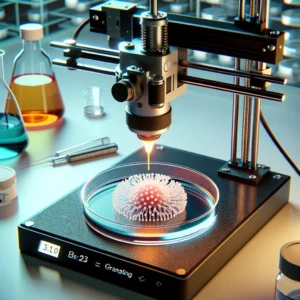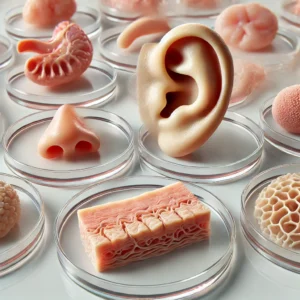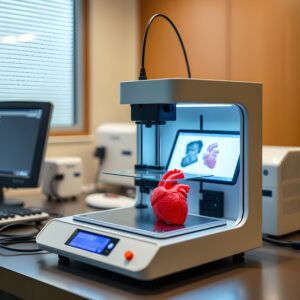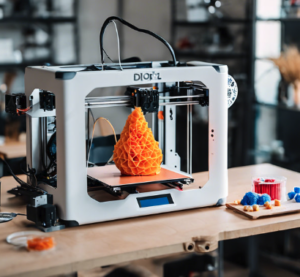What is 3D Bioprinting?

3D bioprinting is a revolutionary technology that applies the principles of 3D printing to biological materials, enabling the layer-by-layer construction of structures using “bio-inks”—substances that contain living cells and biomaterials. This innovative process creates tissue-like structures designed to mimic the behavior and function of natural tissues, with applications spanning regenerative medicine, drug testing, cancer research, and even organ transplants.
Understanding the 3D Bioprinting Process
3D bioprinting begins with detailed imaging of the tissue or organ to be replicated, often obtained through technologies like CT and MRI scans. These scans provide the blueprint for the desired structure, guiding the bioprinter as it deposits bio-inks in precise, layered arrangements. Each bio-ink is specially formulated to support cell health, enabling printed structures to sustain cellular life and gradually develop tissue functionality.
Stages of Bioprinting
- Pre-Bioprinting: Planning, imaging, and creating the digital blueprint.
- Bioprinting Process: The layer-by-layer deposition of bio-inks to form a structure.
- Post-Bioprinting: Structures are matured in bioreactors, where they develop as functional tissues.
Types of 3D Bioprinters
- Extrusion-Based Bioprinters: Ideal for larger tissue structures like cartilage and bone, these bioprinters extrude bio-ink in layers, creating thick tissue constructs.
- Inkjet Bioprinters: Known for their high precision, inkjet bioprinters release tiny droplets of bio-ink, making them suitable for intricate tissues, such as vascular networks.
- Laser-Assisted Bioprinters: Using laser precision, these printers can achieve high accuracy and are often used for delicate tissue constructs.
Applications of 3D Bioprinting in Medicine
Regenerative Medicine and Transplants
The most groundbreaking potential of 3D bioprinting is in regenerative medicine. By printing patient-specific tissues, bioprinting can address organ shortages by creating custom-made organs that reduce transplant rejection risks. Currently, bioprinted tissues like skin grafts, cartilage, and blood vessels are being explored, with future goals aimed at more complex organs.
Drug Testing and Disease Modeling
3D bioprinting also offers an ethical and effective way to test pharmaceuticals. Traditional drug testing relies on animal models, which are limited in mimicking human biological responses. Bioprinted “organ-on-a-chip” models create a realistic human environment, allowing researchers to study drug responses and disease progression with higher accuracy.
Cancer Research and Tumor Studies
In cancer research, bioprinted tissues allow researchers to observe cancerous cells in a laboratory setting that mimics the human body. This approach helps scientists evaluate potential treatments and drugs on bioprinted tumors, yielding more precise insights into how different treatments impact cancer cells.
3D Bioprinting Materials: What Are Bio-Inks?
Bio-inks are the essential materials in 3D bioprinting, designed to encapsulate living cells and create supportive structures for tissue growth. These inks typically include:
- Natural Polymers: Such as collagen, gelatin, and alginate, which are biocompatible and suitable for mimicking soft tissues.
- Synthetic Polymers: Such as PEG (polyethylene glycol), offering more structural stability for harder tissues.
- Cell-Laden Hydrogels: Acting as a supportive matrix, these hydrogels provide an optimal environment for cells to grow and mature after printing.
The ongoing development of bio-inks focuses on enhancing their cell-supportive properties, ensuring they can effectively replicate the structure and function of native tissues.
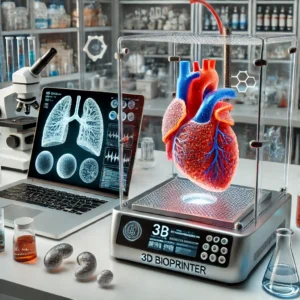 Costs and Accessibility of 3D Bioprinting
Costs and Accessibility of 3D Bioprinting
The cost of 3D bioprinters varies significantly based on complexity, precision, and intended application:
- Entry-Level Bioprinters: Designed for educational and research settings, these printers range from $10,000 to $200,000.
- Advanced Medical-Grade Bioprinters: Used for human tissue applications, these can exceed $500,000 due to the specialized technology and materials involved.
Although currently expensive, bioprinting costs are expected to decrease with technological advancements, making it accessible for more research institutions and healthcare providers.
Challenges Facing 3D Bioprinting
Material Limitations
Creating bio-inks that can replicate the complex structures and functions of human tissues is an ongoing challenge. Bio-inks must balance flexibility, stability, and biocompatibility to support cell health and maturation without compromising the tissue’s structural integrity.
Scalability Issues
While 3D bioprinting has achieved breakthroughs on small scales, large-scale tissue fabrication requires advancements in both technology and bio-ink formulation to ensure tissues can be produced quickly and efficiently.
Ethical and Regulatory Hurdles
Bringing bioprinted tissues and organs to the clinical stage involves navigating stringent ethical and regulatory frameworks. Ensuring safety and efficacy requires extensive testing, and bioprinting’s novelty presents unique ethical questions, especially regarding human organ replication.
Breakthrough Examples in 3D Bioprinting
- Printed Skin Grafts: Scientists have successfully bioprinted skin for burn victims, offering a new method for generating skin grafts that closely match the patient’s own skin.
- 3D-Printed Cartilage: Bioprinting cartilage is advancing to address joint injuries, with potential applications in osteoarthritis treatments.
- Organs-On-Chips: These printed chips replicate organ function on a small scale and are used for drug testing, greatly reducing reliance on animal models.
Future of 3D Bioprinting: Beyond Earth and Into Space
3D bioprinting is extending beyond Earth’s limits. Researchers are exploring bioprinting in space, where microgravity enables the formation of more complex tissue structures. This approach holds promise for medical research and tissue engineering during space missions, potentially supporting human health in long-term space exploration.
The Transformative Potential of 3D Bioprinting
3D bioprinting stands at the forefront of medical innovation, offering a glimpse into a future where personalized healthcare is the norm. With advances in bio-ink development, scalability, and affordability, the widespread use of 3D bioprinting may soon become a reality, addressing organ shortages and transforming regenerative medicine.
Visit our other website: master3dp.com

